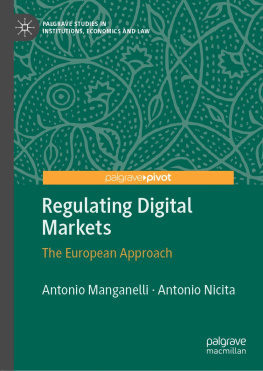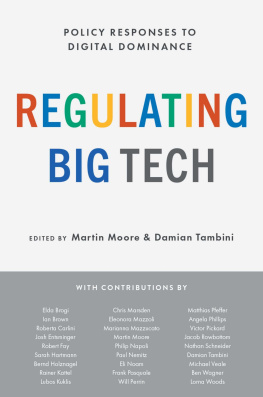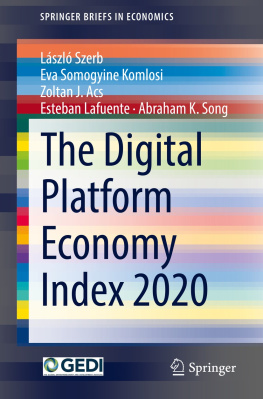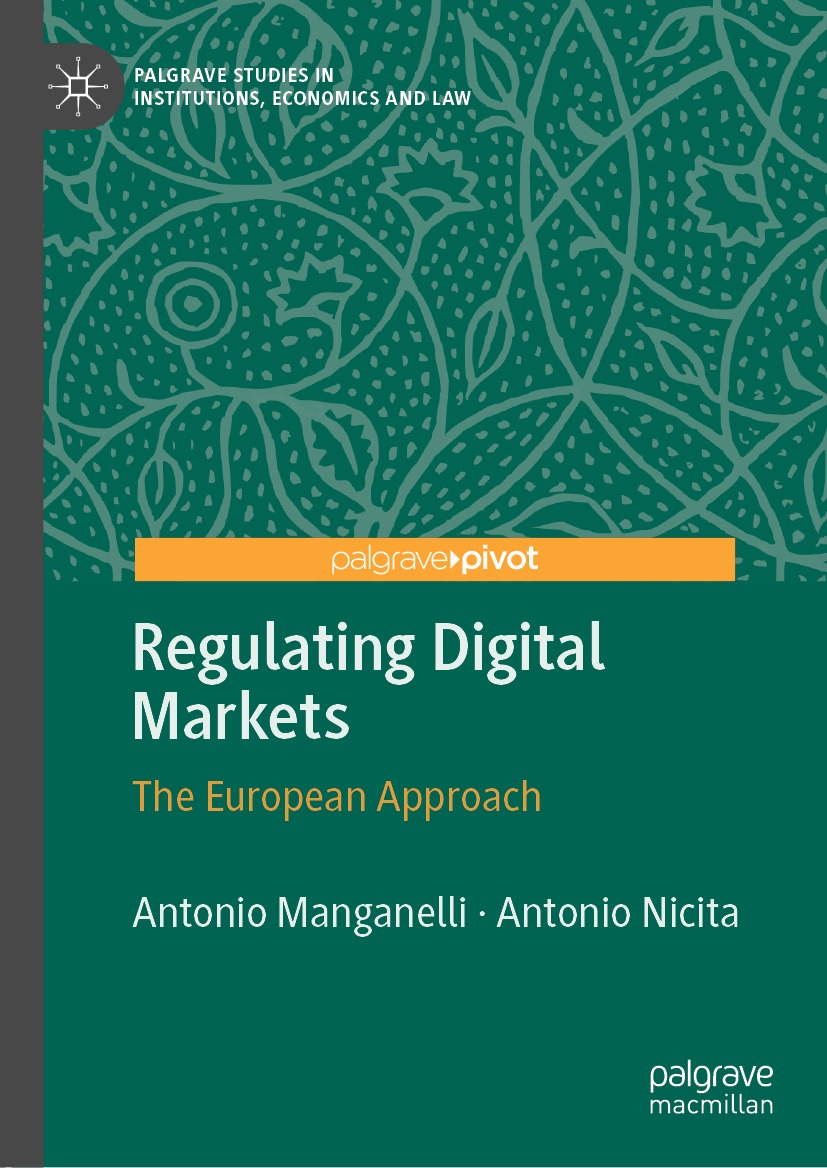Palgrave Studies in Institutions, Economics and Law
Series Editors
Alain Marciano
University of Montpellier, Montpellier, France
Giovanni Ramello
University of Eastern Piedmont, Alessandria, Italy
Law and Economics is an interdisciplinary field of research that has emerged in recent decades, with research output increasing dramatically and academic programmes in law and economics multiplying. Increasingly, legal cases have an economic dimension and economic matters depend on rules and regulations. Increasingly, economists have realized that institutions matter because they influence economic activities. Increasingly, too, economics is used to improve our understanding of how institutions and how legal systems work. This new Palgrave Pivot series studies the intersection between law and economics, and addresses the need for greater interaction between the two disciplines.
More information about this series at https://link.springer.com/bookseries/15241
Antonio Manganelli and Antonio Nicita
Regulating Digital Markets
The European Approach

Logo of the publisher
Antonio Manganelli
University of Rome LUMSA, Rome, Italy
Antonio Nicita
University of Rome LUMSA, Rome, Italy
ISSN 2662-6535 e-ISSN 2662-6543
Palgrave Studies in Institutions, Economics and Law
ISBN 978-3-030-89387-3 e-ISBN 978-3-030-89388-0
https://doi.org/10.1007/978-3-030-89388-0
The Author(s), under exclusive license to Springer Nature Switzerland AG 2022
This work is subject to copyright. All rights are solely and exclusively licensed by the Publisher, whether the whole or part of the material is concerned, specifically the rights of translation, reprinting, reuse of illustrations, recitation, broadcasting, reproduction on microfilms or in any other physical way, and transmission or information storage and retrieval, electronic adaptation, computer software, or by similar or dissimilar methodology now known or hereafter developed.
The use of general descriptive names, registered names, trademarks, service marks, etc. in this publication does not imply, even in the absence of a specific statement, that such names are exempt from the relevant protective laws and regulations and therefore free for general use.
The publisher, the authors and the editors are safe to assume that the advice and information in this book are believed to be true and accurate at the date of publication. Neither the publisher nor the authors or the editors give a warranty, expressed or implied, with respect to the material contained herein or for any errors or omissions that may have been made. The publisher remains neutral with regard to jurisdictional claims in published maps and institutional affiliations.
This Palgrave Macmillan imprint is published by the registered company Springer Nature Switzerland AG
The registered company address is: Gewerbestrasse 11, 6330 Cham, Switzerland
To Bernardo, Cosimo, Davide e Simone,
because tomorrow's world belongs to our children.,
but our thoughts and decisions today start shaping it.
Preface
Digital markets constitute a multifold and multi-layered ecosystem, whose core backbone is made of very high capacity fixed and mobile telecom infrastructures. Those physical infrastructures play a fundamental role by interconnecting users and allowing data communication. Nevertheless, they probably are neither the brain nor the soul of the digital ecosystem. Services, contents, applications, and their providers permeate and shape the digital markets and digital society with sophisticated, pervasive, self-nurturing networks made of economic and social interactions, taking place at various levels in the materiality-immateriality scale.
Digital markets are not a sector of the economy. In fact, there is no such a thing as a digital sector. Digital transformation and digital markets extend horizontally across the entire economy and across all sectors, as well as across the whole society. They also naturally extend geographically, across countries and globally, beyond all political borders.
It goes without saying that the architecture and the functioning of such a system are extremely complex and dynamic, due to its incredibly dense and extended web of interactions and interdependences, on one side, and its exponential (r)evolutionary pace, on the other side. Stakeholders approaching digital markets, e.g., consumers, business users, researchers, policy makers, or regulators, are therefore constantly subject to the risk of analysing specific aspects of the system in an isolated way, or taking decisions subject to inertia or path dependency. In the former case, they would risk to neglect some important aspects or dynamics within the system, possibly producing unintended consequences, while, in the latter, they would risk adopting ineffective, inefficient, or detrimental choices based on outdated information or conditions.
It is indeed quite difficult to get a sound understanding of digital markets functioning and its effect on economy and society; therefore it has been equally arduous for public bodies to govern its dynamics and develop an effective and fair digital policy. This book focuses precisely on the challenges that regulators and policy makers have faced and will face in the transition from the old (network) industries to the new digital ecosystem. Our intent is to describe, in one succinct book, the evolution of the digital economy, its main actors, notably the global digital platforms, as well as its interactions, interdependences, and trade-offs, eventually proposing insights about why public rules are needed, what kind of rules could be more effective, fair, and efficient, and who should pose and enforce them.
Indeed, the digital ecosystem is full of economic and legal interdependences, entanglements, trade-offs, and (apparent) paradoxes. Just to mention a few examples among the several debated within the book, the Digital Market Society is a place where: (i) digital markets, inherently borderless, used to have grater cross-border obstacles than bricks-and-mortar markets; (ii) unregulated platforms create their own (algorithmic) private rules, aiming to extend their effect toward all (erga omnes); (iii) information and communication flows are almost limitless but tend to become artificially chambered; (iv) big digital companies aim to become markets; (v) digital economy have many different faces and digital markets have many different sides; (vi) platforms know so well our preferences to anticipate our needs and even our order requests; (vii) an increase of consumers satisfaction (in terms of preference-matching) may come along with a reduction of consumer surplus; (viii) free services are not free at all, yet implicitly exchanged against economicly valuable personal data; (ix) search costs are extremely low as well as users interest to seek information; (x) the digital information systems most valuable service is not to describe facts but to create emotions.
We do not even try to provide any definitive answer or solution to those digital trade-offs. Our aim is to provide a small contribution to the wider academic and policy debate, which has been roaming and fluctuating, yet is progressively building a Digital Compass











